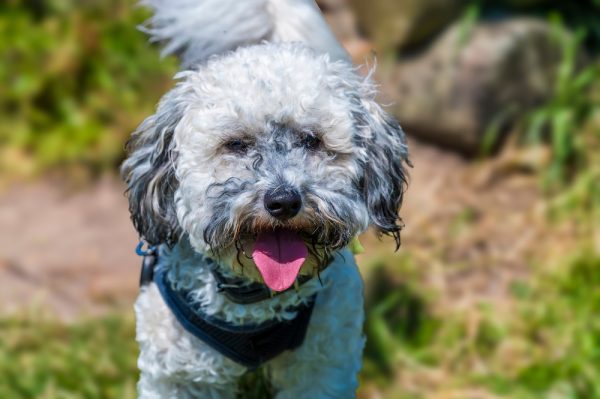In this article
View 8 More +With a nickname that’s hard to forget and a body that demands attention, Dachshunds are easily one of the most well-known dog breeds. These “wiener dogs” might come from Germany, but their popularity in America has been steady for decades. Keep reading to learn all about the short-legged, family-friendly, remarkable dog that is the Dachshund!
Breed Overview
Height:
8–9 inches (standard) 5–6 inches (miniature)
Weight:
16–32 pounds (standard) 11 pounds or less (miniature)
Lifespan:
12–16 years
Colors:
Black, chocolate, fawn, or blue & tan, cream, wheaten, wild boar, red and black, fawn, chocolate, or blue & cream
Suitable for:
Families and individuals with patience and previous experience owning dogs, families with older kids
Temperament:
Curious, friendly, playful, bold, protective, charming, sometimes stubborn
When you hear that the Dachshund dog breed was bred to hunt badgers, their short stature and bold personality suddenly make a lot more sense. Dachshunds come in two sizes, three separate coat types, and multiple colors, making them one of the more unique breeds.
Life with a Dachshund is neither quiet nor boring, and many people simply can’t resist their charms. However, as with any canine, the Dachshund isn’t the right pet for every family. In this article, you’ll learn more about the temperament, traits, and care required to share your home with a Dachshund.
Dachshund Characteristics

Dachshund Puppies

Few people would argue that puppies are generally cute, but baby Dachshunds are especially adorable. According to AKC registrations, Dachshunds are among the 10 most popular breeds, so you’ll have no shortage of options if you’re looking for a puppy.
If you choose to buy a Dachshund puppy from a breeder, be careful to research and screen breeders carefully. Unethical breeding operations like puppy mills frequently produce popular small breeds like Dachshunds. Look for breeders who prioritize the well-being of their dogs and are transparent about answering questions, allow you to view or visit their facilities, and offer health guarantees.
If you prefer to adopt a Dachshund dog, look for breed-specific rescue groups in your area. You can also check animal shelters and humane societies. Purebred dogs get adopted more quickly, and you might need to be patient if you want to rescue a Dachshund.
Once your Dachshund puppy comes home, it’s time to start socializing and training them. Don’t let the cute puppy face fool you—Dachshunds will take over the house if given the chance. If you let bad habits develop when they’re young, it can be harder to retrain adult dogs.

Temperament & Intelligence of the Dachshund
Dachshunds were bred to hunt badgers, which burrow holes in the ground. This task required them to work independently and make decisions quickly. Modern Dachshunds rarely continue this legacy of hunting, but their personalities remain.
The Dachshund is a smart little dog with a mind of their own. They can be stubborn and don’t always want to listen to their owners. However, Dachshunds are also playful, charming, and can be very affectionate to their human family.
Dachshunds are full of personality and generally just entertaining to live with, which explains why they’re so popular. They tend to bark a lot and make great watchdogs. You’ll have to make an effort to shape your Dachshund’s behavior appropriately, but the results are worth it.
Are These Dogs Good for Families? 🏡
Dachshunds can be good family dogs, but they’re best suited for families with older children. Unfortunately, Dachshunds don’t always have the patience to tolerate the rough handling and antics of younger kids. Physically, they’re vulnerable to injuries due to their long backs, too.
While well-socialized Dachshunds can live with younger kids, you must supervise their interactions carefully. Dachshunds won’t be able to play hard with energetic kids like some other breeds, which is something to keep in mind when choosing a family pet.
Dachshunds may not be a good fit for busy families that are rarely home. They are social dogs who need plenty of company.

Does This Breed Get Along With Other Pets? 🐶 😽
Generally speaking, Dachshunds tend to be good with other dogs. However, depending on how they were socialized as puppies, some Dachshund dogs may not get along well with other pets. Their bold, protective personalities can lead them to clash with other dogs. Dachshunds are small dogs who don’t always act like it, which can be dangerous if they decide to confront a larger canine.
However, Dachshunds can enjoy having a dog companion if properly socialized and supervised. Just don’t let them play too rough to protect your Dachshund’s back.
Since they were bred to hunt small animals, Dachshunds may chase cats. Early socialization and pairing the dog with a cat who’s comfortable with canine friends and doesn’t act like prey can help with this tendency. Keep birds and small exotic pets separated from Dachshunds to avoid predator stress or worse.

Things to Know When Owning a Dachshund
If you’re considering adding a Dachshund to your family, you might be curious about what it’s like to live with and care for this breed. Here are the important things you need to know when owning a Dachshund.
Food & Diet Requirements 🦴
Dachshunds can thrive on a complete and balanced diet formulated for dogs. Choose a reputable brand and a diet that meets the nutritional needs of your dog’s life stage, from puppy to senior. Many Dachshunds enjoy eating small-breed dry food because of the reduced size of the kibble.
You may also choose to feed your Dachshund canned or wet food or maybe fresh food delivered to you. Regardless of the food type, remember that Dachshunds can be prone to getting overweight, which isn’t healthy for any dog but can be especially tough on them. Carrying too much weight puts extra strain on the Dachshund’s long back and can leave them at greater risk of spinal problems. Ask your vet to help you calculate how much your dog should be eating each day and stick to it.

Exercise 🐕
Dachshunds are energetic dogs that need daily exercise to keep them mentally stimulated, control their weight, strengthen their muscles, and minimize the risk of back problems. A 2025 study showed that two daily walks of at least 30 minutes (more than 1 hour of daily exercise) have a positive impact on decreasing the likelihood of suffering from intervertebral disc disease. Interestingly, dogs that were not allowed to jump on and off furniture at home were more likely to suffer from disc problems. We highly recommend that you consult your veterinarian about the best exercise routine for your Dachshund.
Dachshunds should also have the chance to exercise their brains each day. Consider interactive and puzzle toys to provide regular mental stimulation.

Training 🎾
Although they’re intelligent dogs, other aspects of the Dachshund’s personality can make them challenging to train. Since they’re bred to work independently, Dachshunds may not see the point of following commands from humans.
They’re also prone to stubbornness. Dachshunds generally respond best to positive reinforcement training techniques. Use short training sessions and be prepared to get creative to keep your dog’s attention. If you use treat rewards as part of your training strategy, remember to subtract the calories from your Dachshund’s total daily allowance.
Grooming ✂️
The time you’ll devote to grooming a Dachshund depends on their coat. Dachshunds don’t shed excessively, but longhaired pups need frequent brushing to keep mats and tangles at bay. Smooth-coated Dachshunds need the least grooming. A quick weekly session with a bristle brush or grooming glove is generally all they need.
Wirehaired Dachshunds need their coats hand-stripped a few times per year. In between, they also need weekly brushing and sometimes a quick trim. Bathe your Dachshund as needed and trim their nails about once a month, depending on how much they wear them down.
You’ll need to include preventative dental care in your Dachshund’s grooming routine. Brush your dog’s teeth regularly or use products like dental chews, water additives, or a special diet. Your vet can help you find the best dental care products.
Health and Conditions 🏥
Although overall considered a healthy breed, intervertebral disc disease (IVDD) is a common problem for them, being 10–12 times more likely to suffer from it than other dog breeds. It is estimated that approximately 1 in 4 Dachshunds will have signs of IVDD at some point during their life.
- Dental disease
- Obesity
- Intervertebral disk disease (IVDD)
- Luxating patella
- Idiopathic epilepsy
Male vs Female
Like most breeds, male Dachshund dogs are larger than their female counterparts. Unneutered males may display more territorial behavior towards other male dogs. They are also more likely to display behaviors like urine marking and humping.
Female Dachshunds will go into heat about twice a year unless spayed. If you don’t plan to breed your dog, talk to your veterinarian about when to spay or neuter them.

3 Little-Known Facts About the Dachshund
1. The Name Dachshund Means “Badger Dog.”
Dachshunds originated from Germany, and their name in the original language reflects their intended purpose. The skilled Dachshunds trailed badgers down into their dens to hunt them.
2. The Different Dachshund Coat Types Serve Specific Purposes.
From the original smooth-coated Dachshunds, breeders created the wire-haired and long-haired varieties. The denser wirehaired coat was meant to protect Dachshunds as they hunted through thorny vegetation. Longer hair kept other Dachshunds warm in cold temperatures.
3. During World War I, Americans Called Dachshunds “Liberty Hounds” Because the Dogs Were Considered a Symbol of Germany.
Since Germany was at war with the United States, Americans called their Dachshunds “liberty hounds” to hide their association with Germany. German Shepherd owners called their dogs “Alsatians.”


In Conclusion
Dachshunds are a uniquely appealing breed in many ways, and it’s no surprise that they’re as popular as they are. If you feel that the Dachshund is a good fit for your household, remember the precautions we mentioned to protect their backs from injury. When researching breeders, ask about the history of disk disease in the family. Consider purchasing pet insurance for your dog, but look for one that covers inherited and breed-specific health conditions.
Featured Image Credit: 4sally scott, Shutterstock




















2 Responses
would like to find a dachshund vetin central il close area
Hello Donald,
thank you for your message and sorry for a bit of a delay. We are unfortunately unable to help you out with this one, however, we believe you will surely find some vet online. Try searching for "vet in central il area" or something similar on Google.
Alternatively, if you would like to receive a veterinarian's input without visiting a clinic, you can book a video call appointment with one of our veterinarians from www.PangoVet.com. Our veterinarians will gladly check your Dachshund, answer all your questions and give you peace of mind.
Hope this helps.